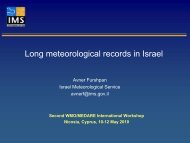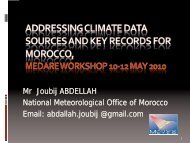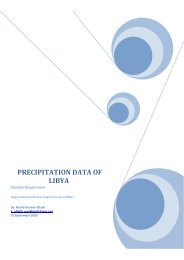MACEDONIA
hydrometeorological service of republic of macedonia
hydrometeorological service of republic of macedonia
- No tags were found...
You also want an ePaper? Increase the reach of your titles
YUMPU automatically turns print PDFs into web optimized ePapers that Google loves.
HYDROMETEOROLOGICAL SERVICE OF REPUBLIC OF<br />
<strong>MACEDONIA</strong>
GEOGRAPHIC PROFILE<br />
OF THE COUNTRY<br />
The Republic of Macedonia is situated in the southern<br />
Europe, in the central part of Balkan Peninsula, at<br />
latitude of approximately 42 o 50’ North and a longitude<br />
of 22 o 00’ East. Total surface area of our country is<br />
25,713 km 2 .<br />
FYRMacedonia borders with Bulgaria, Serbia, Albania<br />
and Greece.
Although it is small in size, it is a very<br />
diverse country. Participation of plains in total<br />
surface area is 19.1%, the figure of reddish<br />
mountain terrains is 79%, where water surfaces<br />
are 1.9%.<br />
From the aspect of topography, FYRMacedonia is<br />
mountainous country. Forests cover more one third of total<br />
territory of the country. Agricultural area cover 25%.
Different types of climate<br />
characterize the country:<br />
continental,<br />
changed continental,<br />
sub Mediterranean<br />
(changed maritime),<br />
mountainous climate,<br />
as well as their various<br />
subtypes.
Hydrometeorological activities in our country<br />
have long and rich tradition<br />
1891 - 1899 first meteorological measurements and<br />
observations were performed<br />
(met.station SKOPJE);<br />
• 1896 - 1911 second meteorological measurements<br />
and observations were performed<br />
(met. station BITOLA);<br />
• 1923 first precipitation station network;<br />
• 1926 first climatological station network was<br />
organized;<br />
• 1947 Hydrometeorological Service was established<br />
• 1993 we became a permanent member of the WMO;
METEOROLOGICAL STATION NETWORK<br />
There are following meteorological stations :<br />
• 14 main meteorological stations;<br />
• 16 climatological stations;<br />
• 160 precipitation stations;<br />
• 4 automated weather stations (2 on the<br />
Airports)<br />
Meteorological data have been archived in<br />
CLIDATA – data base
Addressing climate data sources and key records for the Mediterranean Basin for<br />
the investigation of relationship between large‐scale climate variability and<br />
regional variability of climate, observations from seven Meteorological<br />
Stations could be used together with the large‐scale analysis .<br />
Selected locations represent different climatic types and subtypes affecting the<br />
climate of our territory, which are a combination of three major climate drivers that<br />
meet over the our Region :<br />
Mediterranean,<br />
Continental<br />
and Mountain.<br />
According to the climate types proposed by Ristevski (Filipovski et al. 1996;<br />
Ristevski, 2006), defined mainly with regards to altitude, and according to the<br />
typical annual cycle of mean monthly air temperature and precipitation amount six<br />
geographical regions of FYR Macedonia were treated separately in analysis:
1. south‐eastern part with<br />
sub‐Mediterranean climate;<br />
2. central part with combined<br />
sub‐Mediterranean / continental<br />
climate;<br />
3. southern part with continental<br />
climate;<br />
4. south‐western part with<br />
continental climate;<br />
5. eastern part with continental<br />
climate;<br />
6. north‐western part with<br />
prevailing mountain / Alpine<br />
climate.
SELECTED<br />
METEOROLOGICAL<br />
STATIONS<br />
• DEMIR KAPIJA (1932)<br />
• STIP (1926)<br />
• BEROVO (1925)<br />
• SKOPJE –<br />
PETROVEC(1924)<br />
• PRILEP ( 1923)<br />
• BITOLA (1927)<br />
• LAZAROPOLE (1948)
Hourly measurements and observations of all meteorological elements and<br />
phenomena are performed and recorded in observation reports at all main<br />
meteorological stations except at those stations which work 12 hours.<br />
Continuous measurements have been performed since 1947 at all these stations.<br />
Standard elements and phenomena are measured by basic classic instruments<br />
and their appropriate recording instruments at main meteorological stations<br />
•Temperature<br />
• Relative humidity<br />
• Atmospheric pressure<br />
• Wind direction and speed<br />
• Precipitation quantity and intensity<br />
• Insolation<br />
• Evaporation<br />
• Soil temperature
Temperature (max, min, mean)
Precipitation
Air Pressure
HISTORY RECORDS
Concerning the climate change and climate variability our<br />
Meteorological sector have taken part in preparation:<br />
• FIRST NATIONAL COMMUNICATION UNDER THE UNITED NATIONS<br />
FRAMEWORK CONVENTION ON CLIMATE, 2003<br />
• <strong>MACEDONIA</strong>’S SECOND NATIONAL COMMUNICATION UNDER THE<br />
UNITED NATIONS FRAMEWORK CONVENTION ON CLIMATE, 2006<br />
• PARTICIPATION IN PLAN PREPARATION OF THE HEALTH SECTORE<br />
WHO PROJECT ON HEALTH PROTECTION FROM CLIMATE CHANGE<br />
• MITIGATING CLIMATE CHANGE THROUGH IMPROVEMENT OF<br />
ENERGY EFFICIENCY IN BUILDING SECTORE
STATUS OF DATA AND FUTURE<br />
EXPECTATION<br />
• Not used the longest climate data series, only<br />
monthly climate data series 1926 – 2005;<br />
• Not homogenized data and completely statistical<br />
quality controlled<br />
With MEDARE initiative we can do the first step :<br />
• Try to find historical records since 1891/99 Skopje<br />
Jahrbucher der k.k. Zentral- Amstalt fur Meteorologie und<br />
Erdtmagnetismus, Wien and Bitola 1896/1911<br />
Annales du Bureau Centrale Meteorologique de France, Paris
• Scan and copy first-ever publication of data<br />
• Digitized data which is non-digitized<br />
• Homogenization<br />
All this goals can be achieved with the project proposal<br />
– define the partners platform and exchange policy
Thank you for your attention!





